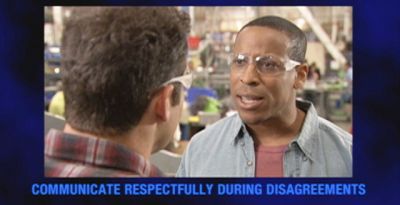5 Tips for Respectful Workplace Communication

When communication breaks down, bad things happen.
A simple misunderstanding wastes hours (or even days) of work. An overheard comment results in hurt feelings and fractured teams. A disconnect in communication styles leads to frustration and lost productivity.
Here are five tips for improving communication in your workplace – tips to help you create respect, increase understanding, and decrease conflict.
1. Consider your audience
We love to feel as if we’re the center of the universe – and in some ways, we are, because we can only ever truly perceive the world from our own perspective.
But that doesn’t mean we shouldn’t try to imagine what other people’s perspectives could be.

Before you speak or write, consider how your audience might receive your message.
- Are you being firm – or whacking them with your words?
Instead of, “Wow, I can’t believe how badly you messed that up!”, try, “Okay, that’s not what I expected. Let’s review this and see where it went wrong.”
- Ask, is now really the best time/place for me to address this issue? What would be the best way for me to approach this person?
When we put ourselves in the shoes of others, especially those who may be going through a difficult time, it demonstrates respect and helps maintain positive workplace relationships.
2. Talk with someone instead of about them
There’s something uncomfortably satisfying about venting your frustration with a sympathetic third party.
 But … how would you feel if you discovered someone was gossiping about you behind your back?
But … how would you feel if you discovered someone was gossiping about you behind your back?
And let’s face it, the only way to solve the problem is to go to the source.
So instead of griping to someone, “Can you believe how Jared’s constantly chit-chatting when we’re trying to get our work done?", try approaching Jared and saying, “Jared, there’s a lot going on and we really need a quiet work environment – would you mind holding back on personal conversations until lunch or break time?”
3. Confirm your understanding of what someone is saying
Your boss asks you to take on a project.

You’re not sure exactly what’s needed, but … it’s intimidating to ask, since you really don’t want to appear stupid.
But when we don’t confirm our understanding of what we’re being asked to do, we run a big risk of heading in the wrong direction.
So practice your active listening skills! Instead of thinking to yourself, “Hm. I guess I’ll figure it out…”, try saying, “So let me confirm exactly what you need…”
4. Know the boundaries of appropriate communication
Everyone – even the most outspoken and apparently uninhibited among us – has things they’re not comfortable with.
 One person’s TMI (too much information!) is another person’s attempt to build friendships.
One person’s TMI (too much information!) is another person’s attempt to build friendships.
Instead of, “Eww – I really didn’t need to hear that!”, try, “That’s a bit more than I’m comfortable hearing – do you mind not sharing that much?”
In a workplace with people of different ages, backgrounds, personalities, etc., you never really know how a joke or story will be interpreted. "Filters" are a good way to keep what you say and do appropriate for work.
5. Communicate respectfully – even (especially!) when you disagree
Disagreements happen. Arguments flare-up. It’s easy to get carried away by strong feelings.
But that doesn’t help. Conflict resolution in the workplace – or anywhere else – comes when at least one of the parties (you?) can take a few deep breaths (proven to help create calm), step back, bite their tongue, and look for a solution. 
Instead of, “I can’t believe you’re being so stubborn!”, try, “I get that you feel strongly about this. Let’s talk it through and see if there’s some common ground.”
Respecting people’s boundaries, looking at things from their perspective, calibrating your style and your stories to fit your co-workers’ preferences – it can seem like a lot of effort.
And it’s worth it when you experience the results: a respectful workplace where people’s differences are honored and everyone can focus on their work, instead of on who’s saying what to whom.
Looking for a little more help?
Try our program The Respectful Communicator


